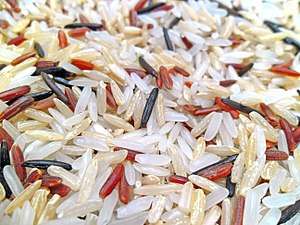Ambemohar
Ambemohar is a fragrant rice variant grown in the foothills of the Western ghats region of the state of Maharashtra in India.
History and etymology
The word Ambemohar means mango blossom in the Marathi language which is spoken in the state of Maharashtra.The rice has strong aroma reminiscent of mango blossoms.The rice has been cultivated in the region for a long time.A century ago about 54,000 tons of the variety was produced in the Mulshi region of the Pune district.[1]
Production and cultivation
The variety is grown in the foothills of the Western ghats region of the state of Maharashtra in India.It is a low yielding rice (1.9 ton/h)a .The grains are short (5.5 mm) and wide (2.2 mm) compared to the well known basmati rice.Both varieties have similar degree of fragrance.[2] The short cooked grains have a tendency to break easily and stick together.The variety is therefore included in the class of Aromatic rice such as Basmati.[3]
Related varieties
Ambemohar is low-yielding compared to other varieties of rice, primarily because it is susceptible to diseases.The hybrid called Indrayani with ambemohar parentage was released in 1987.[4]It was developed by Rice Research Centre near Lonavala[5].Today,Indrayani has replaced Ambemohar in almost all paddy fields in the area.
Lookalikes
It is now rare to find farmers who grow Ambemohar regularly. Since the production cost is high, the retail cost in turn has to be high. So, retailers in Maharashtra, pass off lookalikes as original Ambemohar to gain higher profit margins. This has further discouraged the production of Ambemohar, since the farmers can earn more profit themselves by growing lookalikes. Jeera Sambhar rice from Andhra Pradesh and Jawaful from Madhya Pradesh are the most popular lookalikes sold by retailers.[6]
See also
References
- ↑ Chowdhury, A.R., 2013. Subalternity, State-Formation and Movements against Hydropower Projects in India, 1920-2004 (Doctoral dissertation).
- ↑ Aromatic Rices. Int. Rice Res. Inst. 2000. pp. 8–. ISBN 978-81-204-1420-4.
- ↑ Aromatic Rices. Int. Rice Res. Inst. 2000. pp. 8–. ISBN 978-81-204-1420-4.
- ↑ Aromatic Rices. Int. Rice Res. Inst. 2000. pp. 8–. ISBN 978-81-204-1420-4.
- ↑ Mahatma Phule Agricultural University's
- ↑ Bhosale, Jayashree (Jan 31, 2012). "Consumers pay premium price for the look alike of the regional rice varieties". Economic Times. Retrieved October 8, 2018.
